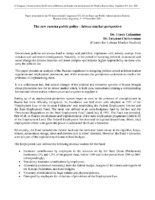| dc.contributor.author | Lakunina, Liana | |
| dc.contributor.author | Chetvernina, Tatyana | |
| dc.date.accessioned | 2018-09-02T05:17:18Z | |
| dc.date.available | 2018-09-02T05:17:18Z | |
| dc.date.issued | 2001-11 | |
| dc.identifier.uri | http://cladista.clad.org//handle/123456789/1790 | |
| dc.description.abstract | This paper presents an analysis of the Russian experience in designing policies aimed at labour market regulation and employment promotion, and of the measures the government undertook to resolve the problems of implementing them. | |
| dc.description.abstract | Setting up of an employment promotion system began as soon as the presence of unemployment in Russia had been officially recognized. Its foundation was laid down with adoption in 1991 of the "Employment Law of the Russian Federation" and establishing the Federal Employment Service and the State Employment Fund. Three stages can be differentiated in the evolution of the Employment Fund from the moment of its establishing to making the decision on its abolishment from 2001. | |
| dc.description.abstract | Stage one (1991 - 1993): regional structures of the Federal Employment Service were developing fast, rather low level of registered unemployment was maintained. The Employment Fund revenues exceed its expenditures, large surplus was accumulated by many regional employment funds. | |
| dc.description.abstract | Stage two (1994 - 1995): the level of registered unemployment increased more than three times from 1992; registered unemployment was growing particularly fast in depressed oblasts that could be clearly identified as subsidized ones (12 regions). By 1995, first signs of loss of control over the processes began to emerge. There were no clear-cut principles of financial relations between the center and the regions. The federal Centre lacked any effective mechanism of formation and re-distribution of the federal part of the Fund. At the same time, the regions did not consider themselves responsible for non-observance of their financial obligations to the Centre. | |
| dc.description.abstract | Stage three (1996 - 1999): signs of the coming all-Russia crisis were becoming more numerous and obvious. The number of regions in need of financial assistance increased tenfold, while the number of donor regions dropped to two. The Centre was not anymore in a position to keep under control collecting and spending its resources. Thus, the government could not set going the mechanism of regulating inter-regional employment differentials as most of the regions failed to discharge their financial obligations to the federal part of the Employment Fund. | |
| dc.description.abstract | The 1998 crisis exacerbated further the difficult situation of the Employment Fund. Impossibility for the system to go on functioning in its present form became quite obvious, and a decision was made to change it radically. It is too early yet to try to evaluate efficiency of the new system. At present its implementation is hindered by lack of legislative framework that would allow to regulate the newly emerging situation. | |
| dc.description.abstract | However, the upward trend in the registered unemployment is already visible, which might be the result (leaving aside social and economic reasons) regional departments of employment losing to some extent their "interest" in underreporting registered unemployment for the purpose of saving resources allocated for unemployment benefit payments. It is safe to assume that subjectivism of decision making might be replaced by that of forecasting the labour market situation. | |
| dc.format.extent | 12 p. | |
| dc.language | Inglés | |
| dc.publisher | Institute of Economics Russian Academy of Science. Centre for Labour Market Studies | |
| dc.rights | Creative Commons BY-SA-NC 4.0 Int | |
| dc.rights.uri | http://creativecommons.org/licenses/by-nc-nd/4.0/ | |
| dc.subject | CONGRESO CLAD 6-2001 | |
| dc.subject | POLITICA LABORAL | |
| dc.subject | POLITICA DE EMPLEO | |
| dc.subject | MERCADO DE TRABAJO | |
| dc.subject | EMPLEO | |
| dc.subject | DESEMPLEO | |
| dc.title | The new Russian public policy : labour market perspective | |
| dc.type | article | |
| clad.congress | Congreso Internacional del CLAD sobre la Reforma del Estado y de la Administración Pública, 6 | |
| clad.key | MFN31642--31642 | |
| clad.key1 | KEY31642 | |
| clad.md5 | 7545f6f7257c31d2d4e64f0013b213d2 | |


